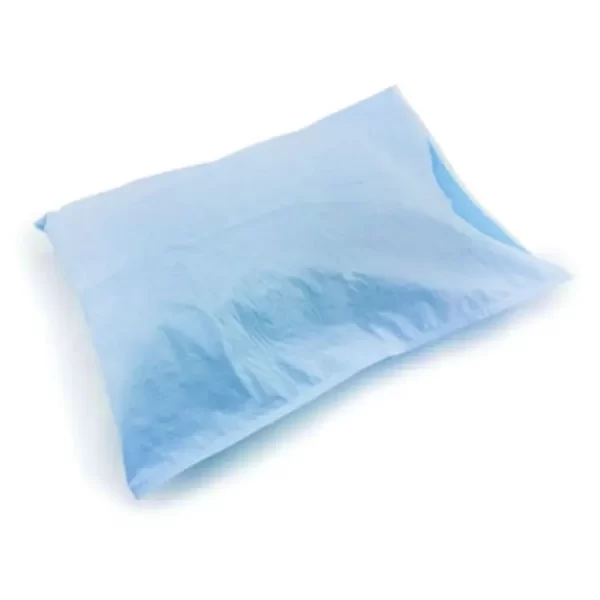Table of Contents
The manufacturing process of disposable pillow cases, much like any other product, is a fascinating journey of transforming raw materials into a finished product that provides convenience, hygiene, and a touch of comfort to the end-users. Given the critical role these disposable pillow cases play in various industries, including healthcare, hospitality, and beauty, it’s essential to understand their manufacturing process. This knowledge not only offers valuable insights into their quality, durability, and environmental footprint but also helps businesses make more informed, value-driven decisions.
Step 1: Material Selection
The first, and perhaps the most critical, step in the manufacturing process of disposable pillow cases is the selection of raw materials. A variety of materials are used to produce disposable pillow cases, with each offering its unique advantages. Here are some commonly used materials and their characteristics:
Non-Woven Polypropylene
Non-woven polypropylene is a type of plastic that is both lightweight and robust. Due to its water-resistant and breathable properties, it is widely used in the healthcare sector, where fluid resistance and air permeability are of utmost importance.
Bamboo
Bamboo fibers have gained significant attention in recent years for being a sustainable and eco-friendly choice. Naturally antibacterial, exceptionally soft, and breathable, bamboo disposable pillow cases offer an excellent blend of comfort and hygiene.
Recycled Fibers
In line with the global push towards a circular economy, many manufacturers are now utilizing recycled fibers. These fibers, typically derived from used textiles or waste plastic, can be repurposed to create durable and eco-friendly disposable pillow cases.
Each material choice aligns with the specific needs of different sectors, and hence the selection largely depends on the intended use and desired properties of the pillow cases.
Step 2: Fiber Processing
Once the material is selected, the next step involves processing it into thin, fine fibers. This procedure typically involves shredding the raw material into small pieces and then stretching and pulling these pieces to create fine strands. These strands are then laid out and intertwined, creating a lightweight, non-woven fabric that forms the basis of the pillow case.
For plant-based fibers like bamboo, the process involves additional steps. The raw bamboo is first pulped, using a combination of mechanical and chemical processes, and then extruded to form fibers. Despite being a bit more complex, the process ensures the inherent properties of bamboo, such as its antibacterial nature and softness, are retained in the final product.
Step 3: Fabric Formation
The processed fibers are then transformed into a non-woven fabric using a technique known as spunbonding. This method involves laying out the fibers in a web-like structure and bonding them together using heat, chemicals, or pressure. The spunbonding process creates a fabric that is not only strong and durable but also retains the individual characteristics of the fibers, whether it’s the water resistance of polypropylene or the softness of bamboo.
Step 4: Cutting and Sewing
Once the non-woven fabric is ready, it is then cut into the desired shape and size for the pillow cases. This cutting process is typically automated, with high-precision machines ensuring each piece of fabric is uniformly cut. These cut pieces are then sewn together using industrial sewing machines. Given the disposable nature of these pillow cases, the seams are designed to be robust, yet easily opened when the pillow case needs to be discarded.
Step 5: Finishing and Packaging
After the sewing process, the pillow cases go through the finishing process. This involves pressing the pillow cases to smooth out any wrinkles, inspecting each piece for quality assurance, and adding any extra features, if necessary, such as zippers or Velcro closures.
The finished pillow cases are then ready to be packaged. This is another crucial step, as the packaging not only protects the product during transportation but also provides necessary information to the end-users, such as the material, size, and care instructions. The packaged pillow cases are then shipped to various establishments around the world, ready to offer a clean and comfortable experience to their end-users.
Impact of Technological Advances
The manufacturing process of disposable pillow cases is not static; it evolves with advancements in technology and changes in market needs. The industry has seen significant technological advancements in recent years, aiming to increase efficiency, improve product quality, and reduce environmental impact.
For instance, innovations in material science have led to the development of biodegradable and compostable materials that can serve as an eco-friendly alternative to traditional plastics. These materials, when used in the manufacturing of disposable pillow cases, can help reduce the product’s environmental footprint.
Similarly, advances in manufacturing technology, such as automation and machine learning, have enhanced efficiency and precision in the production process. Machines equipped with sensors and AI algorithms can monitor the production process in real-time, identifying any potential errors or defects, and adjusting the process accordingly to maintain optimal product quality.
These advancements not only result in a superior product but also contribute to sustainable and responsible manufacturing practices.
In conclusion, the manufacturing process of disposable pillow cases is an intricate blend of material science, engineering, and technology. It’s a process that has been refined over time to meet the increasing demand for high-quality, hygienic, and sustainable solutions in various industries. By understanding this process, establishments can ensure they choose products that align with their specific needs and values, thereby offering the best possible service to their guests or patients.
Please visit our website for more product details https://medposnonwoven.com/product/disposable-pillow-cases/

